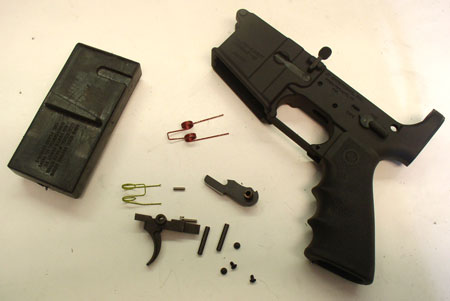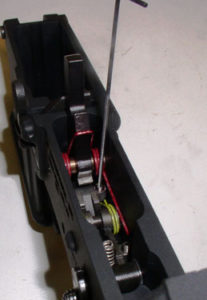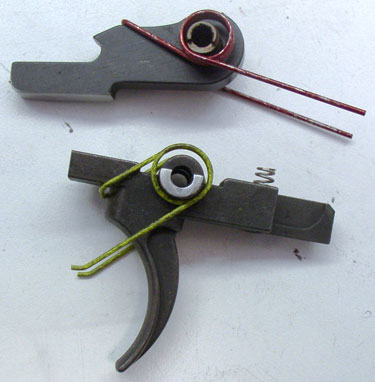
Installing a new AR-15 trigger can make a world of difference. Several companies make great aftermarket AR parts. Let's look at some.
As we all know, the AR-15 has become “America’s rifle” in more ways than one. In its latest incarnations, it continues to serve on in our armed forces. As has been shown in this column on more than one occasion, this rifle has spawned an entire host of products to improve performance, ergonomics, or just to make it look cooler.
Most owners would agree that one aspect of this firearm that needs the most improvement is the fire control system. In other words, folks want a better trigger.
While the triggers on most factory rifles work, they tend to be heavy, creepy, often gritty, and exhibit a fair amount of take-up and overtravel. The creep, long take-up, and grittiness can be ascribed to the sear engagement; the more sear engagement there is the longer it will take the trigger to “break” (take up), and poorly polished surfaces will cause the grittiness.
Overtravel is the distance the trigger moves backwards after it breaks. Trigger pull weights are almost entirely a function of the hammer spring power, which forces the hammer’s sear engagement surface against the sear. A more powerful spring will increase the trigger pull. A more powerful trigger return spring will also have some effect on the pull weight, but it’s minor compared to the effect from the hammer spring.
Like all the other systems on the gun, there are aftermarket parts — really good ones — to improve your trigger function. In fact, several manufacturers use these triggers as OEM parts in some of their product offerings. A number of two-stage systems are available, including modular units, from Jard, Jewell, Chip McCormick, Geissele, Timney, and from several of the rifle manufacturers. Single-stage trigger units are available from Jard, Chip McCormick, and JP Enterprises. (I’m going to go out on a limb and assume that the reader knows the difference between a single stage and a two-stage trigger).
The setup covered in this column is the unit from JP Enterprises. It’s the single-stage trigger kit I have the most experience with and one that is very, very good. JP offers a kit that includes only the trigger with spring, another that includes and entire fire control package with hammer, springs, disconnector, and anti-walk pins. It also offers a modular fire control unit that drops into the empty hole in a lower receiver with an adjustable selector/safety included.
One reason to write about this package is it’s often installed incorrectly — to be more precise, not correctly enough. The kits come with an extensive instruction sheet and installation CD that are more than adequate for the beginner. But I’m going to replicate this installation more concisely, touching on the “not so correct” points.

Let’s Get Started
Get a magazine well vise block from Brownells and put it in your vise. The first thing to do with the parts is to separate and degrease them thoroughly, particularly the screw threads on the trigger. Clean out your lower, as there’s no sense installing a super-cool trigger and other stuff if you don’t bother to clear the housing of filth.
Put a small dab of red Loctite on two of the trigger pin screws. Screw these onto one end of each of the trigger/hammer pins. Make sure the pins will fit in your receiver; they’re slightly oversized and may be a very tight fit. (In rare cases, if the pins will not slide in or gently tap in with a plastic mallet, then the holes will have to be reamed.)
You’ll likely have to knock the very top corner tip off the safety engagement surface on the back end of the trigger in order to clear the selector as you push the trigger down into the receiver. Take the trigger, place the trigger return spring on it, and insert it into the receiver.
Here’s where it helps greatly to have two simple tools: Buy two extra firing pins and grind or cut the tips off. These make a perfect “slave pins” for installation and are inexpensive. Use them to retain the trigger and hammer in the receiver during the installation process.
Hammer Springs 101
Important point: Thanks to poor advice given on the internet, it’s become popular to make a lighter trigger pull by reversing the hammer spring on the hammer so it’s installed backwards.
This doesn’t work. Springs are designed to work in one direction. By putting the hammer spring on backward (it’s easily done), the spring force is inconsistent: The hammer will not always fall with enough force to ignite the primer because the spring isn’t building up and releasing the energy it was designed to produce.
The JP kits come with your choice of three different hammer spring strengths. Yellow is three pounds, red is 3.5 pounds, and gray is 4.5 pounds. The yellow is most often used for match or varmint setups, red for match (enhanced reliability) and duty use, and gray for duty and DCM matches.
Adjust, Adjust, Adjust
Once the trigger and hammer are installed, you can add the overtravel adjustment screw. Cock the hammer. Take the shorter of the two small headless screws, dab a bit of red Loctite on it (don’t skimp, you can always wipe off the excess), and screw it in all the way.
Place your least favorite thumb in front of the hammer to prevent the hammer from hitting the receiver. Then hold the trigger back and unscrew the screw until the hammer falls. Do this a couple of times and then go just a teeny bit farther. There should be just the tiniest bit of trigger jiggle, with no interference with the hammer once the trigger is pulled.
If you’re holding the trigger back and you hear a slight scraping noise when you rotate the hammer, you don’t have enough overtravel.
Unscrew it a tiny bit more until the scraping goes away. If there’s more than a tiny jiggle, you’ve got too much. This is why you do it a few times — to “feel” it out. It’s easier than it sounds. Just go to release and add a small bit more. If you’re one of those clowns who actually likes lots of overtravel, then by all means, turn the screw out to your heart’s content.
Now set the sear adjustment screw. With the hammer cocked and red Loctite on the remaining headless screw, turn the screw in until the hammer falls on your thumb. Back it out a bit, recock the hammer, and do it again. Repeat five more times. The bent leg of the hex wrench gives a good clock measurement for this task.
Once you’re sure you know where the trigger breaks — say, 6 o’clock from your vantage point — back the screw out one full turn. Then screw it one-quarter turn back in and stop. This will give you three quarters of a turn of sear engagement.
For safety reasons, don’t reduce this. You’ll find that this is more than adequate and is about one millionth the engagement of a standard factory trigger.

Connect the Disconnector
Now install the hammer pin. Take the disconnector and insert it into its slot on the trigger. If you’re lucky, the whole assembly will work perfectly now. For those of you not so blessed, we now need to time or “fit” the disconnector.
This is arguably the most important piece of the fire control unit. It keeps the gun from slam firing, not firing, and doubling. It happens to be very cheap and easy to replace if you screw this up, as it is also the same part that everyone uses in their semi-auto ARs.
The usual fitting issue involves the disconnector hook on the hammer. It almost always has too much engagement so the trigger won’t reset when it is released.
The solution is very simple. Take the disconnector back out and stone off the tip of the hook on the disconnector a bit at a time until the interference is just barely there. When the hammer is being cocked it should just nick the disconnector. This will give maximum disconnector engagement with the minimal amount of trigger reset.
When you stone that hook on the disconnector, it will slowly become a facet instead of a point. That’s okay, just keep that flat parallel with the trigger pin hole in the disconnector. It’s kind of like finding the North Star by following the imaginary line extending down from the rightmost two stars in the big dipper. Just extend the imaginary line through the center of the hole.
Now put the selector on safe. You can’t do it, can you? You need to take the trigger back out and slowly grind down the safety pad extending from the back of the trigger until, when cocked, the selector will engage on safe with miniscule to no trigger jiggle when safed. The selector should be able to go about halfway to safe when the unit is uncocked.
When this is done, insert the trigger pin, and top the two pins off with their final screws, each with a dab of blue Loctite. This will allow you to get them out later with minor effort, yet will keep the screws from backing out on their own.
Testing the Result
With your thumb in place, cock and fire the trigger multiple times, each time holding the trigger back until the hammer is recocked. Releasing the trigger should then release the hammer from the disconnector, allowing the trigger to fully reset.
If the hammer falls on the block when the trigger is released, then somewhere along the way you took too much material off the front of the disconnector. To remedy this, slowly remove material from the bottom of the nose — that pointy thing on the front of the disconnector — until it will properly engage. The trigger when released should come to rest precisely as the hammer is released from the disconnector.
Once you have that perfect, cock the hammer with the trigger held back to engage the disconnector. Now flick the hammer by pulling it further back and releasing it. The disconnector should catch it. If it doesn’t, try increasing the disconnector hold on the hammer by stoning the nose.
If this doesn’t work, send the whole shebang to JP to have them do it. JP has special triggers held in reserve to fit in receivers with this issue.
The trigger pull should be extremely crisp, light and have no discernable take up or creep. Remember that this is a single stage trigger and will break quickly and cleanly, and has a remarkably short reset.
You may have noticed that there is a lot “take this part out, adjust it, and put it back in” action going on here. If you’re a gunsmith, you should be used to this, and it should be no problem. If you’re not a gunsmith, do it anyway. This is a fire control unit that is designed to be adjusted to your desired settings (safety first overall) and then left alone.
Going in after the fact to change something, other than springs, pretty much involves redoing it. Do it right the first time. Be sure to watch the video. I like to see things done before I actually do them myself.
After initial safety testing, let the Loctite set overnight. Finally, the safety fit can be avoided by using JP’s adjustable selector. Just fit the trigger parts and set the safety with the set screws in the adjustable selector. It saves lots of time.
Go Shoot It
I used to think that standard triggers were not too bad. Not anymore. For the cost of a big sharp-edged free-float Picatinny handguard tube, you can refine the feel of your rifle to a far better result, and improve your accuracy with this JP trigger kit.

Next Step: Get your FREE Printable Target Pack
Enhance your shooting precision with our 62 MOA Targets, perfect for rifles and handguns. Crafted in collaboration with Storm Tactical for accuracy and versatility.
Subscribe to the Gun Digest email newsletter and get your downloadable target pack sent straight to your inbox. Stay updated with the latest firearms info in the industry.

![Best Concealed Carry Guns In 2025 [Field Tested] Wilson Combat EDC X9S 1](https://gundigest.com/wp-content/uploads/Wilson-Combat-EDC-X9S-1-324x160.jpg)


![Best 9mm Carbine: Affordable PCCs [Tested] Ruger Carbine Shooting](https://gundigest.com/wp-content/uploads/Ruger-Carbine-Shooting-100x70.jpg)
![Best AR-15: Top Options Available Today [Field Tested] Harrington and Richardson PSA XM177E2 feature](https://gundigest.com/wp-content/uploads/Harrington-and-Richardson-PSA-XM177E2-feature-100x70.jpg)
